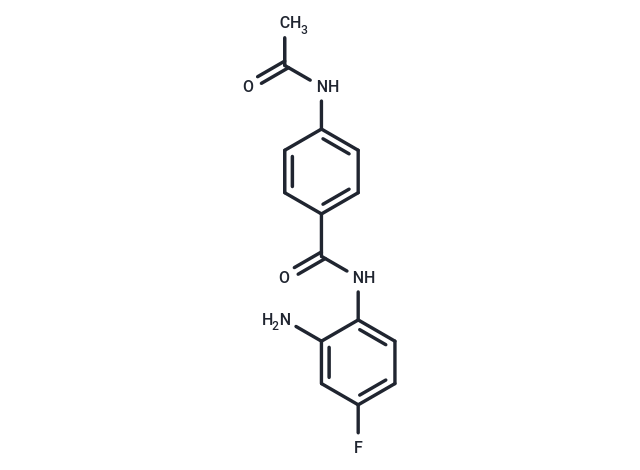Shopping Cart
- Remove All
 Your shopping cart is currently empty
Your shopping cart is currently empty

BRD3308 is a highly selective inhibitor of HDAC3(IC50 of 54 nM), attenuating PE-mediated phosphorylation of ERK but not JNK.

| Pack Size | Price | Availability | Quantity |
|---|---|---|---|
| 1 mg | $38 | In Stock | |
| 2 mg | $54 | In Stock | |
| 5 mg | $87 | In Stock | |
| 10 mg | $128 | In Stock | |
| 25 mg | $233 | In Stock | |
| 50 mg | $352 | In Stock | |
| 100 mg | $528 | In Stock | |
| 1 mL x 10 mM (in DMSO) | $97 | In Stock |
| Description | BRD3308 is a highly selective inhibitor of HDAC3(IC50 of 54 nM), attenuating PE-mediated phosphorylation of ERK but not JNK. |
| Targets&IC50 | HDAC1:1260 nM , HDAC1:5100 nM (Ki) , HDAC3:29 nM (Ki) , HDAC3:54 nM , HDAC2:1340 nM , HDAC2:6300 nM (Ki) |
| In vivo | BRD3308 is a selective HDAC3 inhibitor,to reduce hyperglycaemia and increase insulin secretion in a rat model of type 2 diabetes.?At diabetes onset, an ambulatory hyperglycaemic clamp was performed.?HDAC3 inhibition improved hyperglycaemia over the study period without affecting weight gain.?At the end of the hyperglycaemic clamp, circulating insulin levels were significantly higher in BRD3308-treated rats.?Pancreatic insulin staining and contents were also significantly higher.?These findings highlight HDAC3 as a key therapeutic target for β-cell protection in type 2 diabetes[1]. |
| Animal Research | Male Zucker Diabetic Fatty (Obese) rats (6-week-old); 5 mg/kg; Intraperitoneal injection; every second day |
| Molecular Weight | 287.29 |
| Formula | C15H14FN3O2 |
| Cas No. | 1550053-02-5 |
| Smiles | CC(=O)Nc1ccc(cc1)C(=O)Nc1ccc(F)cc1N |
| Relative Density. | 1.382 g/cm3 (Predicted) |
| Storage | Powder: -20°C for 3 years | In solvent: -80°C for 1 year | Shipping with blue ice. | |||||||||||||||||||||||||||||||||||
| Solubility Information | DMSO: 52 mg/mL (181 mM) | |||||||||||||||||||||||||||||||||||
Solution Preparation Table | ||||||||||||||||||||||||||||||||||||
DMSO
| ||||||||||||||||||||||||||||||||||||

Copyright © 2015-2024 TargetMol Chemicals Inc. All Rights Reserved.